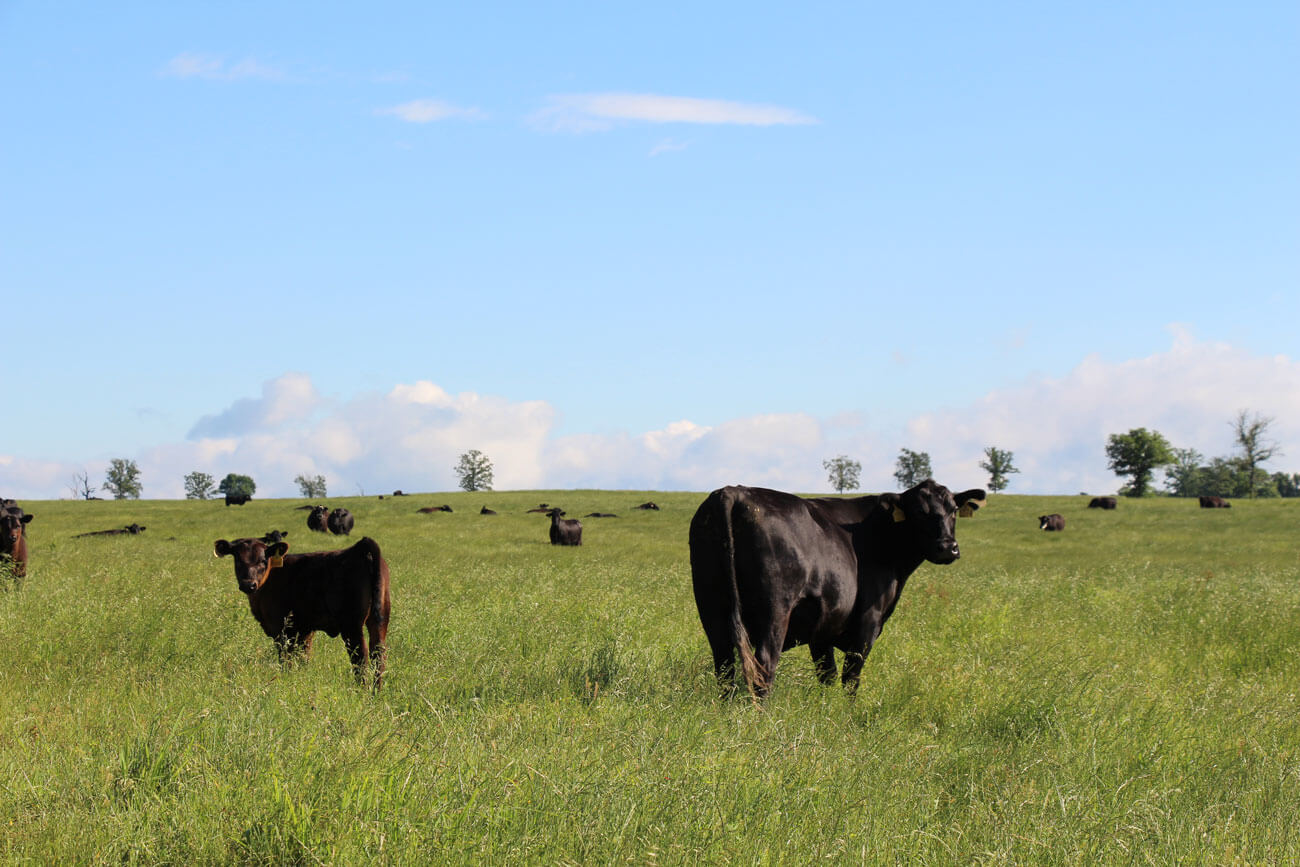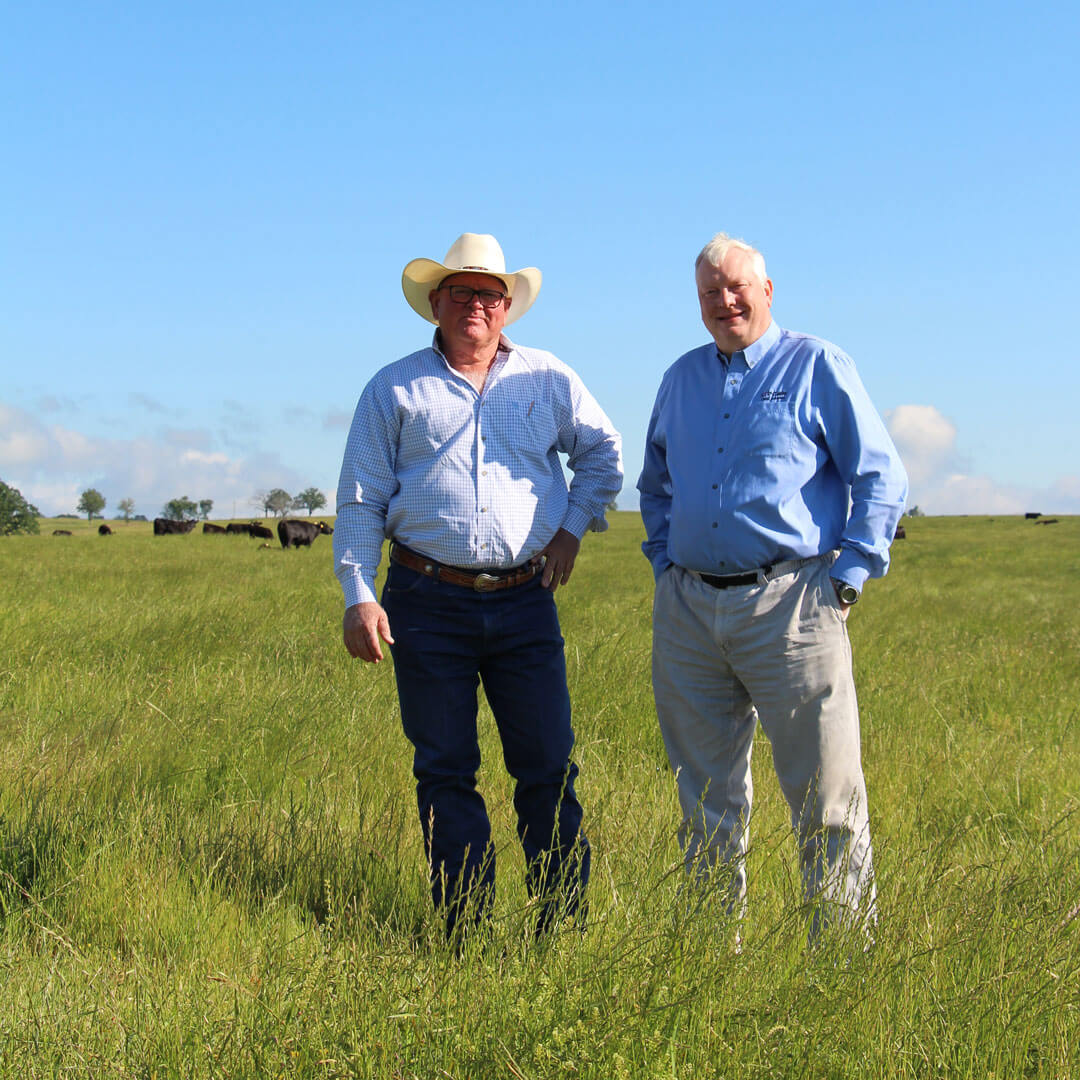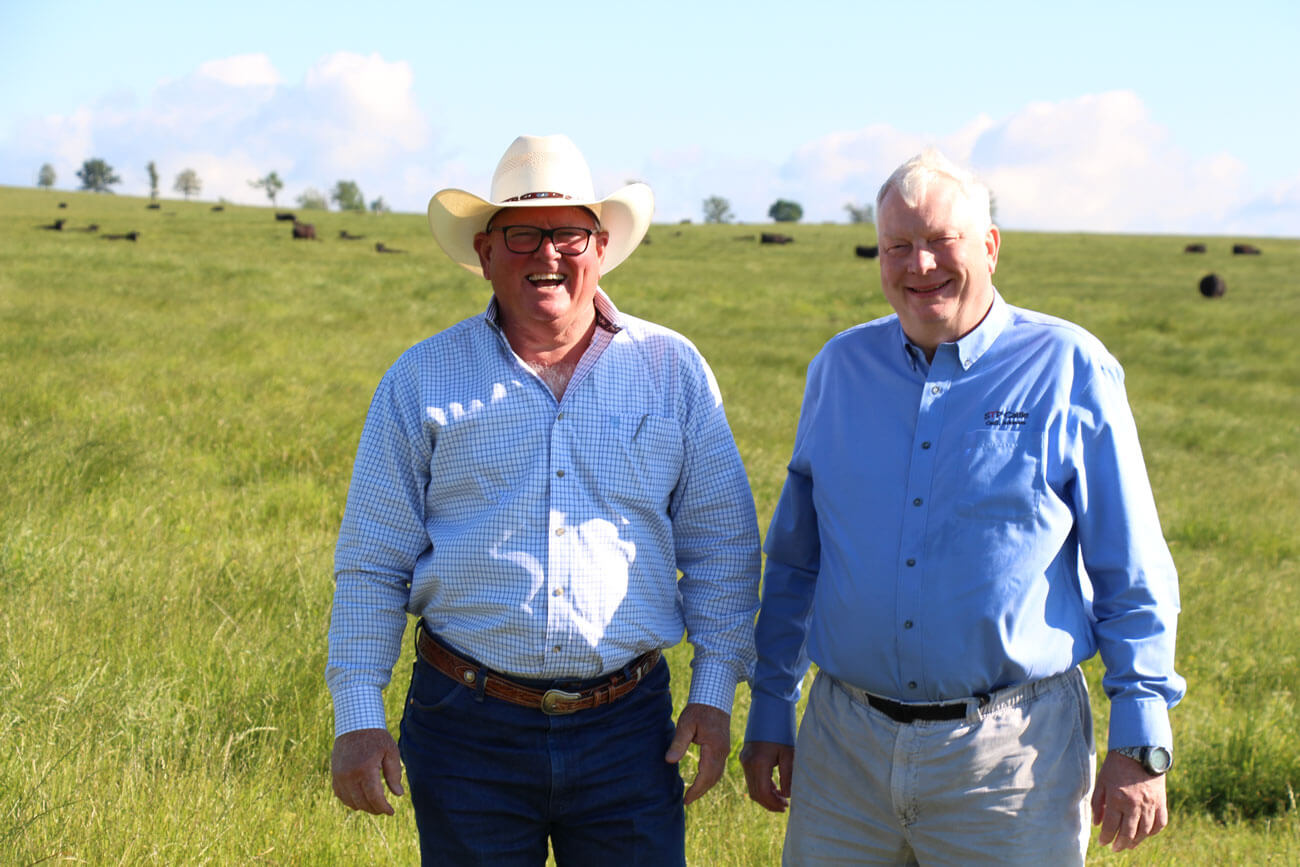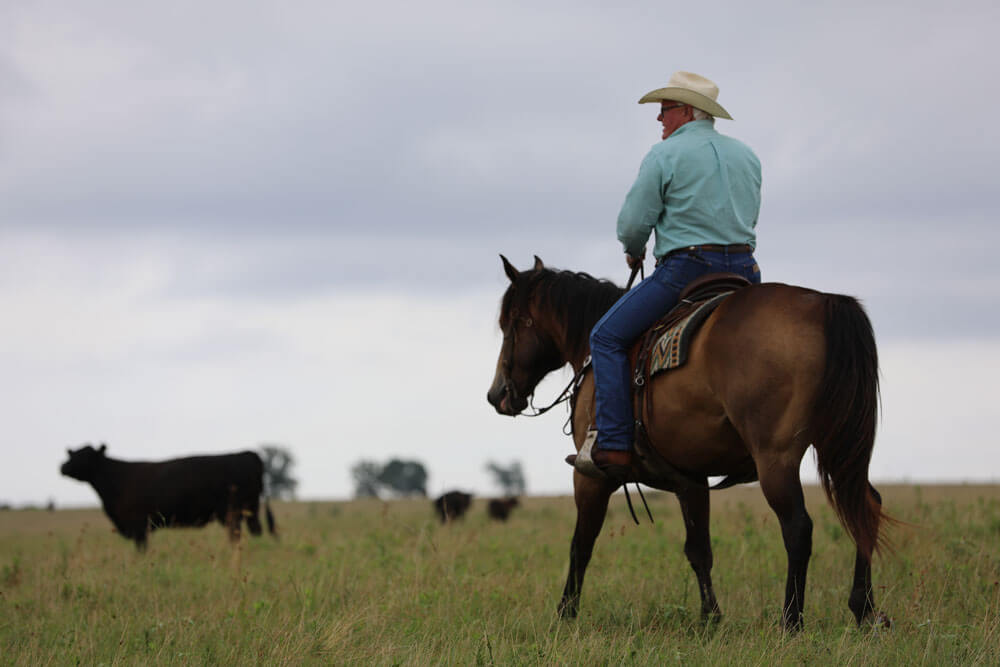A hardware salesman and a hand surgeon walk into a pasture…
For Phillip Smith and Dr. David Taylor, there’s no need for a punch line. What might sound like the start of a tall tale is a typical Tuesday afternoon.
Cattle have always been in the cards for these cousins from Ozark, Ark. Their grandfather, John Jacob Taylor, settled there in the Cecil community after the Civil War and brought cows soon after.
“Back then this was row cropped in cotton,” Smith says. He tells of ancestors with orchards who sold fruit “—whatever they could sell off the land—” but cattle soon took root and provided a smarter harvest.
“Any kind of cropping just doesn’t work well here,” Smith pronounces.
“The soil is silicone based,” Taylor adds. “It’s thin and retains little water, but we grow grass really well so cattle are the best way to approach it.”
Then the corner of his mouth starts to shift.
“It’s just a giant solar panel that takes oxygen, carbon dioxide, water and sunlight to produce grass,” he says. “Grass doesn’t have a lot of value, but we have these great machines out here, these black machines,” he laughs, “that take that grass and make something of high value.”
It’s true, evidenced by a recent closeout of the cousins’ cattle that says 73% achieved Certified Angus Beef ® (CAB®) and Prime.
“Having pride in what you are producing is very important,” Taylor says. That’s why he and Smith raise cattle with a specific purpose and why CAB honored them with the 2018 Commercial Commitment to Excellence Award.

Their partnership, STP Cattle, is built on what the brand stands for, and those “machines” are top of the line.
“We want to grow something Phillip and I wouldn’t hesitate to eat ourselves,” Taylor says.
So in 2009 they purchased a tract of land and combined resources. From there they researched their options, analyzed every possible avenue and reached a conclusion: there are economic opportunities and additional profit to be made for those willing to produce high-quality cattle.
“I mean, we have the grid system in place now that reflects that,” Taylor says.
They background calves, sort off replacement heifers and then finish the rest to see those dollars. But how can we see why the unlikely duo committed to The Business Breed?
“I guess, to bring to life The Grateful Dead, what a long, strange trip it has been,” Taylor says.



Better together
Born a year apart, he and Smith grew up together near the 65-acre homestead their grandfather purchased in 1865. Family, but even better friends, they went through adolescence and high school together before Taylor went to college and Smith carried on his father’s legacy in hardware and electrical work in town.
All the while he kept a herd of “sale-barn cattle,” but Taylor sold his herd of similar quality after his parents’ early passing. It was medical school and surgical residency after that.
Cattle and circumstances called him back.
“It just kind of evolved,” Taylor says. Life led him to an almost-retirement that puts him back in Cecil “four out of every 14 days” to check cows.
The Dallas-based doctor spent years studying and decades fixing people before picking cattle up again as a second job. Nerve reconstruction, improving on birth defects, his specialties earned distinction from peers and gratitude from patients. Both bring humility to Taylor, who enjoys the chance to bring precision to what many consider the simpler world of ranching.
“Is there anything you would suggest we improve,” he asks visitors observing the herd. No matter the information he holds from hours of research, he knows there’s always more to learn, something he and Smith can do better.

Fast and furious
The commercial pairs grazing both sides of the road reflect that desire. The simple terms they use to describe partnership goals seem inadequate to account for how their cattle appear: planned out, with intention behind every mating.
“We want a bull that has balance, strength, no extremes in one area or another,” Taylor says. An expected progeny difference (EPDs) in the high percentiles for marbling with moderate birth weight and frame size rank high on their list of sire qualifiers. Docility can serve as a tiebreaker.
Discouraged by the cost of replacement heifers that met their strict standards, the cousins started selecting for and breeding their own.
“The bulls that we are purchasing for AI [artificial insemination] and cleanup aren’t typically terminal sires, so they pretty much have to do everything,” Taylor says.
They find those bulls at Gardiner Angus Ranch, near Ashland, Kan., even though they AI every female.
“We have more control over our own destiny,” Smith says. “We’re selecting bulls that we could never possibly own.”
One result? Carcass quality is on the rise.
That’s not all.
“AI simplifies the management,” Taylor says. By shortening the breeding window—80% of STP calves are born in the first 30 days of the season—they’ve seen improvement in management, marketing and grass, he says.
It all ties together in a near-complete package that Tom Williams, Chappell (Neb.) Feedlot, takes off their hands come December. Since STP has both spring- and fall-calving herds, Williams will feed four or five groups of “peewees” off of corn stalks, weighing 550 lb., throughout the spring before the fall calves arrive.
He credits the cousins’ use of technology and genetics as reason for improvement – acknowledging the cattle were off to a good start the first day he ever saw them.
“I’d classify their cattle this way,” Williams says: “They were among the better cattle we’ve fed when they came [back in 2010] maybe top 15-20%.”

In the six years since, STP cattle have improved in marbling, cutability and performance, “now being the top or one of the top,” Williams says. “And we feed the good ones.
“I just believe there’s likely no one else in America that puts the detail into selection that he [Taylor] does,” Williams says. The doctor visits the feedyard twice a year, in the meantime sending the manager new research he’s found, or inquiring about how to get better.
“Being a hand surgeon, somebody told me, ‘he’s going to be a detail guy.’ Well, he is, and you know, it shows up in his cattle too.”
Details
What’s behind the improving performance and uniformity?
“My guess is he’s got a frame score on every cow, probably down to the hundredth,” Williams says. On top of that, ribeye area [REA] and marbling are improving in tandem. An average of four groups show 14.6-inch REA actual on a 14.4 REA required for the carcass weight in yield grade calculations; the most recent had a 14.2-inch REA actual on a 13.6 required as more proof of continuous improvement.
“Not many people can do that,” Williams says. “That’s on 400 or 500 a year I’m feeding.”
For Taylor and Smith, that’s merely par for the course to compete with the best. To do that, they utilize available resources to their advantage.
Technologies such as reproductive tract scoring have eliminated cystic ovaries or other abnormalities that can exist in the uterus. Indexing for return on investment from retained ownership helps them eliminate the bottom end of future calf crops. Then there’s DNA-based evaluation.
“Genomic testing is a game changer,” Taylor says. “It’s revolutionary.”
With 40% of heifers in the mix, Williams says he’s not even getting the best STP has to offer. Even so, they are always above average. While gaining nearly 700 lb. in the yard, they’ll boast an average daily gain of 3.9 lb. and convert at a ratio of 6.4 to 1. Yield grade 4s are held to 5% while, on average, 66% qualify for the CAB brand and its CAB Prime extension.
“We feed a lot of northern cattle here, obviously more than southern,” Williams says. “When I drive by them in the lot, I’ll tell people, ‘These cattle are from Arkansas,’ and they just give me this ‘What?’ face like they can’t believe it.”
For that part of the world, it may be easier to raise something that’s less straight Angus, Williams says. “But phenotypically, these cattle are stout, their frame size fits their muscle package and they marble. He’s striving for 100% CAB.”
Striving—perhaps that’s the best way to describe the cousins, rather than driving through their herd on a sunny afternoon. They’re on a good trajectory that keeps getting better.
Check out more great stories
$100,000 Up for Grabs with 2024 Colvin Scholarships
Certified Angus Beef is offering $100,000 in scholarships for agricultural college students through the 2024 Colvin Scholarship Fund. Aspiring students passionate about agriculture and innovation, who live in the U.S. or Canada, are encouraged to apply before the April 30 deadline. With the Colvin Scholarship Fund honoring Louis M. “Mick” Colvin’s legacy, Certified Angus Beef continues its commitment to cultivating future leaders in the beef industry.
Carcass Quality Set to Climb Seasonally
With the arrival of the new year the beef market will rapidly adjust to changes in consumer buying habits. This will remove demand pressure from ribs and tenderloins, realigning the contribution of these most valuable beef cuts to a smaller percentage of carcass value
Raised with Respect™ Cattle Care Campaign Launched This Fall
Raised with Respect™ was developed as part of a strategic cattle care partnership between Sysco and CAB. The collaboration focuses on supporting farmers and ranchers, equipping them with continuing education to stay current on best management practices and helping to increase consumer confidence in beef production.



